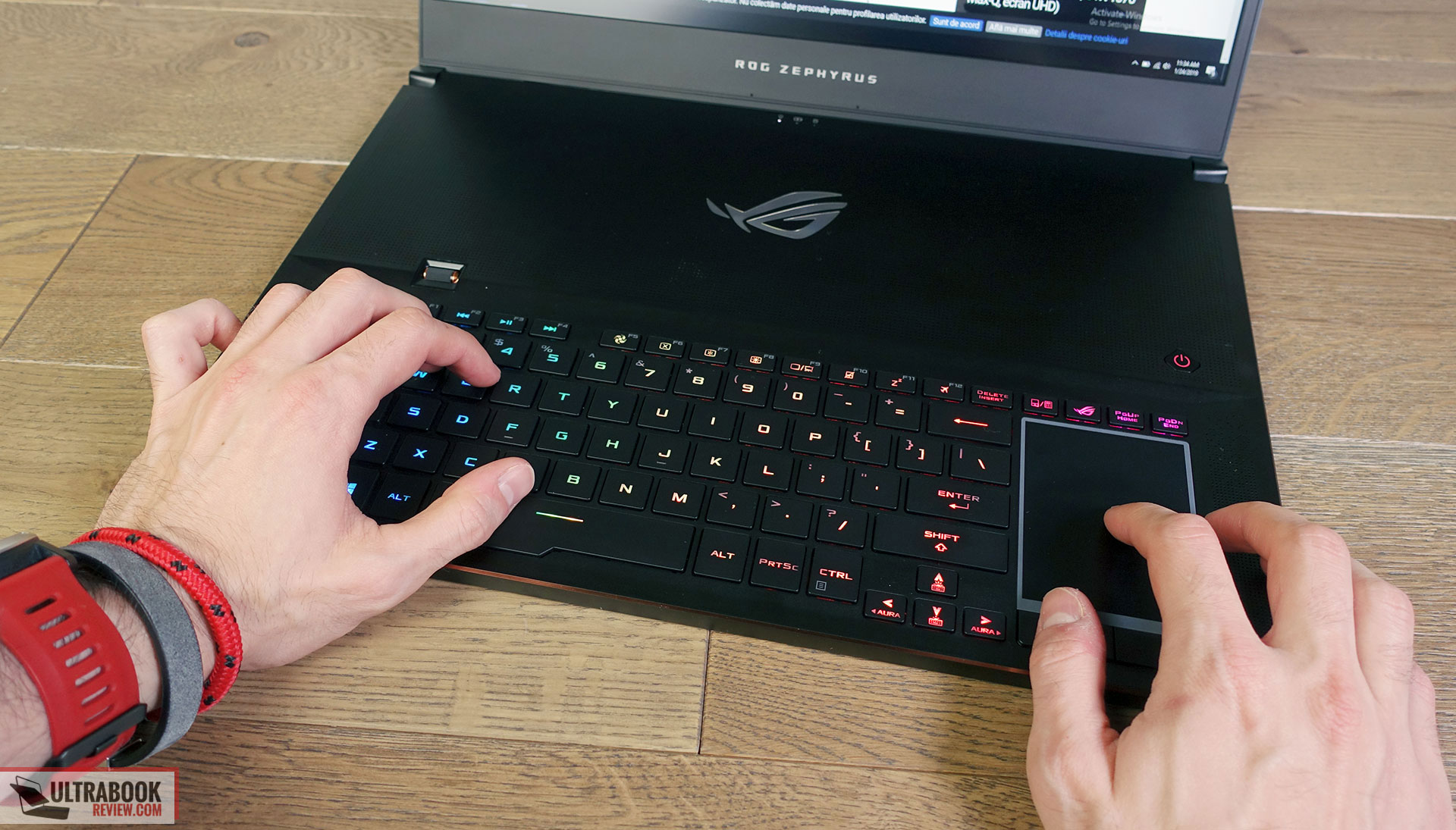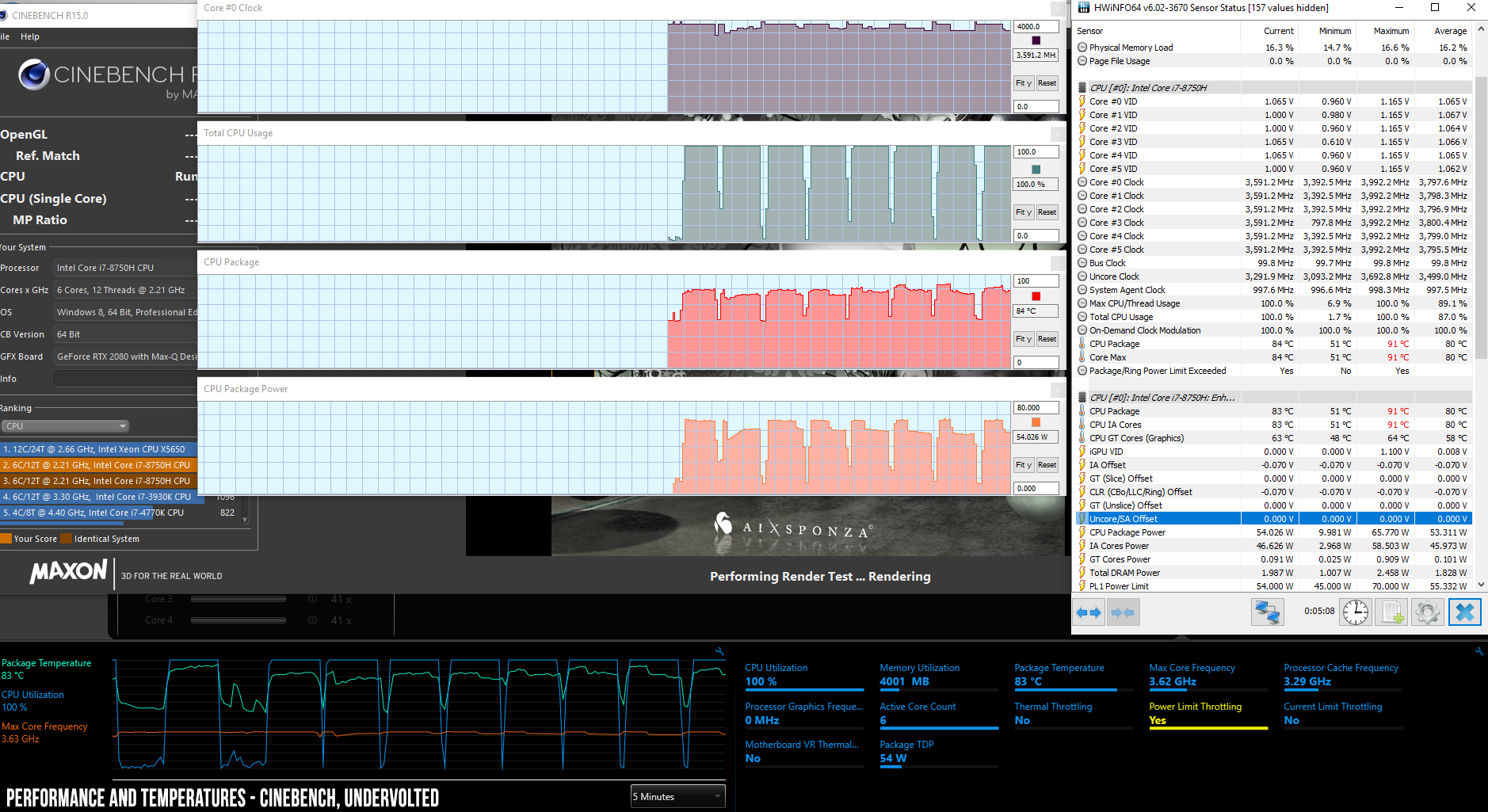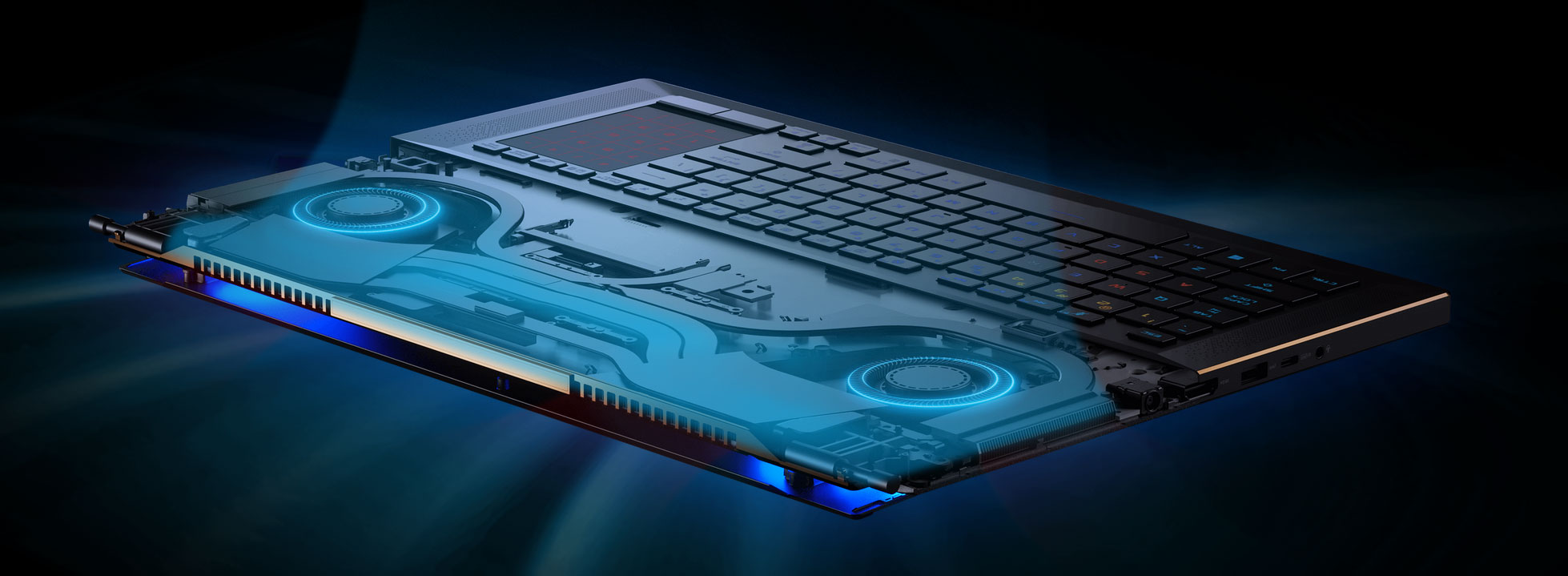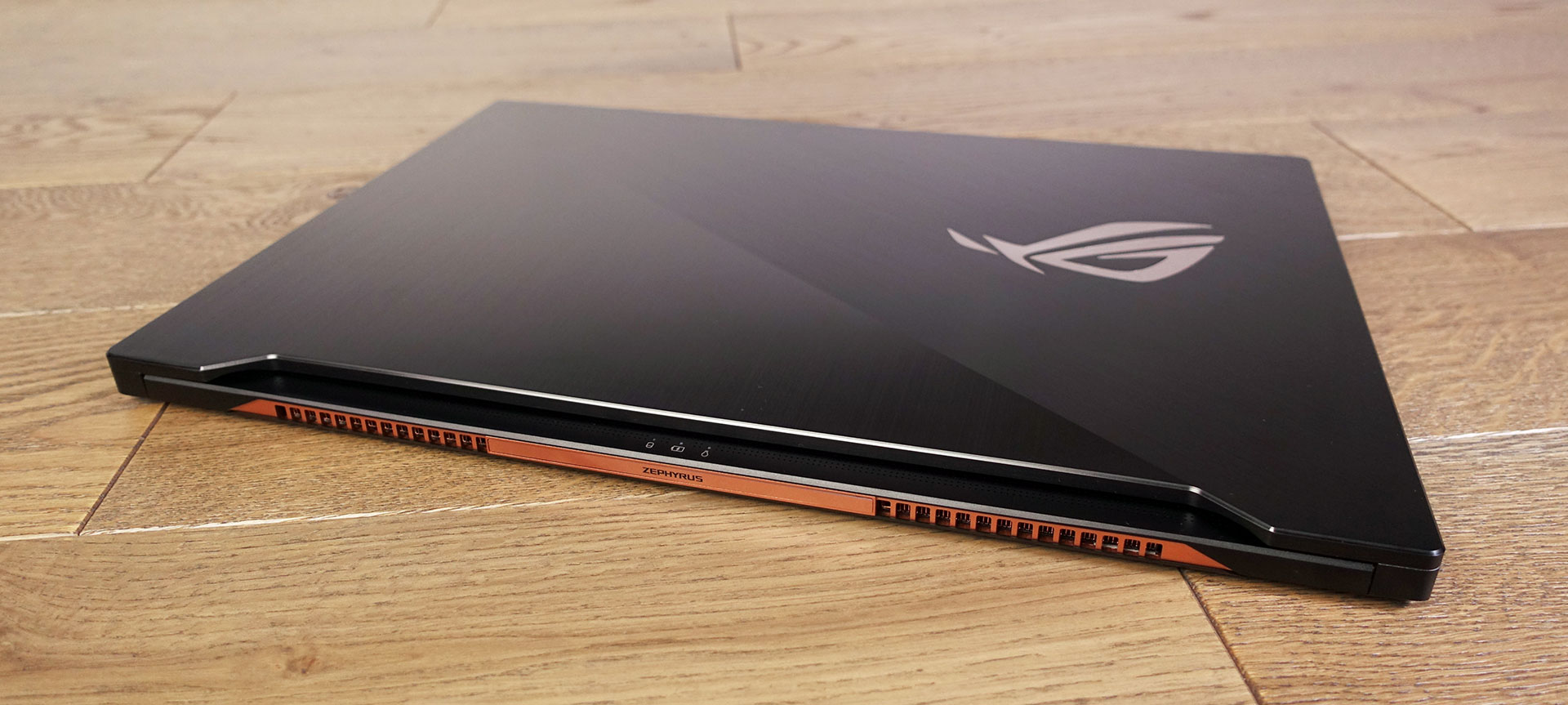Asus ROG Zephyrus S GX701 review (GX701GX model – Core i7, RTX 2080 100W)
This article is a detailed review of the Asus ROG Zephyrus S GX701 GX gaming ultraportable, in the top-specked configuration with a Core i7 processor, Nvidia RTX 2080 Max-Q graphics and 1 TB of SSD storage.
Quite a few 17-inch thin-and-light gaming notebooks built on RTX platforms were announced early into 2019, and the Zephyrus GX701 from Asus is one of the first to hit the shelves. It builds on the 15-inch Zephyrus S GX531 launched in 2018, keeping some of its traits and design lines, and adding a few extras on top: a bigger battery, front-facing speakers and a 17-inch screen with slim bezels, 144 Hz refresh-rate and G-Sync, as well as the updated hardware.
Unlike other GSync laptops though, this also offers an Optimus mode that you can opt for if you’re looking for longer battery life with daily use, which will definitely appeal to those interested in an all-around laptop for both work and fun. However, its particularities make the GX701 primarily a desk-notebook and not that much the laptop you can comfortably use on the lap or in other on-the-go situations, and we’ll explain why throughout this article.
We’ve spent the last few days with the Zephyrus S GX701 GX and gathered all our impressions below, with the strong-points and the quirks you’d better be aware of before spending the $3000+ Asus asks for the high-end configurations. Our initial article was based on a pre-production version of the GX701 GX, but we later tested a final retail version of this Zephyrus as well, and updated our findings throughout the article.
Specs as reviewed
Asus ROG Zephyrus S GX701GX
Screen
17.3 inch, 1920 x 1080 px, IPS, 144 Hz, G-Sync, Pantone Validated, non-touch, matte
Processor
Intel Coffee Lake-H Core i7-8750H CPU
Video
Intel HD 630 + Nvidia RTX 2080 Max-Q 8 GB (100 W)
Memory
24 GB DDR4 2666 MHz (8GB soldered + 1x DIMM)
Storage
1 TB SSD ( Samsung PM981 MZVLB1T0HALR) – single M.2 NVMe 80 mm slot
Connectivity
Wireless AC (Intel AC 9560), Bluetooth 5.0
Ports
3x USB-A 3.1, 1x USB-C gen 2 with DP and PowerDelivery, 1x USB-C gen 1, HDMI 2.0, mic/earphone, Kensington Lock
Battery
76 Wh, 230 W brick
Size
399 mm or 15.7” (w) x 272 mm or 10.7 (d) x 18.7 mm or .73” (h)
Weight
5.82 lbs (2.64 kg) + 1.63 lbs (740 g) power brick, US model
Extras
per-key RGB backlit keyboard, FHD external webcam, stereo front-facing speakers
Asus offers this laptop in a handful of other configurations, the differentiating factor being the graphics chip inside, with an RTX 2060 GPU in the Zephyrus S GX701GV and RTX 2070 Max-Q graphics in the Zephyrus S GX701GW. They share all the other traits, so most of this article applies to any of these variants.
Design and build
The ROG Zephyrus S GX701 is one of the smallest 17-inch gaming laptops on the market, and also one of the lighter models, at around 5.9 lbs. In all fairness, there are some lighter 17-inch ultraportables out there, but the GX701 is light enough for a device that does not compromise on the build quality or the choice in materials.
In fact, the GX701 is pretty much a slightly larger version of the 15-inch Zephyrus GX531, just large enough to accommodate a 17-inch screen with tiny side and top bezels, but still a fairly chunky chin, which I actually don’t mind, as it pushes the screen upwards in a more ergonomic position in front of my eyes.
It also inherits some of the unique traits of the Zephyrus S line, like the fact that the keyboard and touchpad are placed lower onto the inner frame, where you’ll normally find the arm-rest with regular notebooks, in order to leave room for the cooling system above, as well as the mechanical raising mechanism that pushes the chassis up in order to allow better air intake on the bottom. The screen also only leans back to about 110 degrees, and all these make the GX701 a compelling desk-laptop, but also one that you’ll struggle with in other situations. I find this rather contradicting on a device that’s supposed to be portable, as this is compact and light nonetheless, but still needs to stay on a spacious desk to be actually useful.
The GX701 also builds on the same design lines as the GX531. Metal is used for the entire outer case, with some good quality plastic around the display, and the build is mostly sturdy and premium, with little flex in the screen and interior. I would also add that this laptop looks beautiful, although I would have liked the option to switch off that big ROG logo on the hood. That’s not possible though, as it’s lit by the screen’s panel, but you can control and switch off the RGB logo at the top of the keyboard. The power button and the status LEDs placed just beneath the screen are also always lit and can be distracting when watching a movie in a dark room.
This 17-inch Zephyrus does get a few unique traits of its own though, my favorite being the front-facing speakers that are flanking the keyboard and touchpad. Asus pretty much took the keyboard/touchpad of the GX531 and filled in the extra space with speakers, and they sound much nicer and clearer than those on the 15-inch model. Asus also implemented a neat mechanical volume-wheel that allows to easily adjust the volume or mute the speakers when pressed.
You’ll also notice that there’s no camera at the top or at the bottom, and that’s because Asus ditched it entirely and replaced it with a supposedly better external USB camera (included in the pack in most regions).
I can see how you might occasionally need a webcam and not have it around or how you can lose it over time, but for the most part, I can accept this compromise for a better quality webcam. What you get is only alright though, better than with other Asus laptops, but not necessarily better than with some of the other internal cameras available out there. I don’t have a GX531 around, but I am curious about a side-by-side comparison with its integrated camera.
All in all, I had a great time with the ROG Zephyrus GX701 in daily use. It’s sturdy enough so you don’t have to worry about it breaking when throwing it in your backpack, although you might want to get some sort or sleeve, as the metallic surfaces can scratch easily. The grippy feet allow it to sit sturdily on a desk and you can lift-up the screen with a single hand, easily grabbing it from the knob on the front lip.
As for the IO, you’ll find it lined on the edges, with most ports and the DC-In jack conveniently placed on the left side. In fact, this is pretty much a computer for right-handed users, due to the touchpad’s placement.
I’ll also add that there’s no card-reader and no Thunderbolt 3 on the Zephyrus GX701, but only two USB-C slots, one of them with support for DisplayPort and Power Delivery. There’s no LAN either, so you’ll have to rely exclusively on Wireless, or perhaps use an USB to LAN adapter when needed.
At the end of the day though this is not a computer for everyone. Yes, it’s well made and light and portable for a 17-incher, but at the same time the design, the keyboard/touchpad placement, the screen-angle, the mechanical raiser or even the lack of an included webcam make it much more usable as a desk computer, thus the thin-and-light aspect will only come in handy when actually having to carry it around.
Of course, you might argue that you’ll mostly keep such a laptop on a desk anyway, working or playing games, hooked up to an external mouse, but how about when you’re not? I for one see this kind of devices as a jack of all trades, good for both work and fun, and the GX701’s design might not have what it takes to cover all needs.
Keyboard and trackpad
Much like the other Zephyrus S models before and other thin-and-lights with powerful hardware, the GX701 gets the keyboard placed where you’ll normally find the palm-rest on most laptops. That’s unusual, and makes using this device on the lap or leaned on the thighs fairly uncomfortable, but it’s actually practical while it sits on a desk, where the experience resembles that of typing on a regular desktop keyboard.
This keyboard gets a standard layout, with a deck of well-sized and spaced keys, but smaller arrows which can be a little difficult to find with daily use. There’s no NumPad, as this keyboard is identical to the one on the GX531, and feels the same as well. The touchpad can be switched into a NumPad with the click of a button, disabling the cursor, but don’t expect this to feel like a regular physical NumPad, as hitting the virtual keys lacks any sort of feedback.

That aside, this keyboard is rather on the shallow side, with little key travel (1.4 mm) and soft actuation, so this resembles the keyboards you’ll find on many modern ultrabooks. As a result, some of you might consider it a tad mushy, but I actually found this to be a great typer, very fast and fairly accurate once I got used to the feedback. This is also quiet, so it checks many of the boxes I want in a compelling keyboard.
Asus also implements n-key rollover and per-key backlighting, with some bright LEDs and various control options accessible in the Armoury Crate app, as part of the Aura sub-section. The F1-F12 marking on the function keys doesn’t light up though. You can sync the keyboard’s lighting with Asus’s peripherals and the RGB ROG logo at the top of the keyboard, in case you’re all into RGB.
The illumination can also be activated by swiping your fingers over the touchpad, without having to press a key, but the doesn’t feel as seamless as with regular laptops due to the touchpad’s positioning. On most laptops, it seems that the keys light up by simply putting your hands over them, even if in reality that’s done by swiping the hands over the touchpad on their way to the keys, and that’s not the case when the touchpad sits at the right.
Speaking of that, I was expecting to hate the unusual touchpad placement, crammed to the right, but I actually got used to it, as the experience resembles that from a desktop computer, where the right hands sits on the mouse. However, that’s only while keeping the device on a desk, much like with the keyboard.
Of course, there’s no way around the fact that this touchpad is small and narrow and sometimes you’ll feel like there’s not enough room to move the cursor around or perform gestures. The cursor is also rather slow out-of-the-box, but you can boost its sensitivity from the settings, as this gets Precision drivers. Its surface is also a bit sticky and doesn’t allow the fingers to glide as easily as with glass implementations, but even so, this is not bad. I also like the physical buttons at the bottom, which are clicky and quiet, but again small and perhaps a little difficult to find in the dark.
I’ll also add that the GX701 lacks any sort of biometric login options, with no finger-sensor or IR cameras, so you’ll have to rely on typing your password each time you want to log in.
Screen
Asus puts one of the better 17-inch 144 Hz panels on the market on the Zephyrus GX701, the AU Optronics B173HAN04.0 that they also use on the ROG Scar II GL704 series.
This is an IPS panel with mid-level brightness, contrast and color accuracy, as well as fast-response times, no PWM and G-Sync support. Details below, taken with a Spyder4. Keep in mind that other sites will report higher brightness/contrast levels, and that’s mostly because our tool measures brightness and contrast by switching between a white and black image, while other methods measure black and white points after having them on on the screen for a longer period.
- Panel HardwareID: AU Optronics AUO409D (B173HAN04.0);
- Coverage: 96% sRGB, 70% NTSC, 74% AdobeRGB;
- Measured gamma: 2.2;
- Max brightness in the middle of the screen: 279 cd/m2 on power;
- Contrast at max brightness: 930:1
- White point: 7100 K;
- Black on max brightness: 0.30 cd/m2.
- PWM: No;
- Response time: 3ms advertised, 7.5 ms GtG.


This panel is fairly well-calibrated out-of-the-box (also Pantone Validated, according to Asus), but you can further correct the White Point and slight Gray-level imbalances with this calibrated profile.
As a side note, we noticed two issues with the panel on this particular sample: some light bleeding around the corners, actually visible on dark backgrounds when watching a movie, as well as some color-uniformity problems in the lower half, which we were not however able to spot with the naked eye. Such quality control issues are random with modern panels, and there’s no way to prevent them; all you can do is buy from a place that allows returns in case you end up drawing a short stick.
Hardware and performance
Our test model is the higher-end configuration of the ROG Zephyrus S GX701GX, with the Core i7-8750H processor, 24 GB of RAM, the RTX 2080 Max-Q graphics chip and a 1 TB NVMe SSD.
Our review unit is a retail model with fairly mature drivers from Nvidia (GeForce version 419.67), thus our findings should be in line with what you should expect from the models you can find in stores.
The GX701 has a few hardware particularities. It only supports up to 24 GB of RAM, with 8 GB soldered on the motherboard and an extra memory DIMM, but the memory still works in dual-channel. It also gets two NVMe drives, and according to the specs only one of them is hooked to a PCIe 4x connection, and the other is a slower PCIe 2x. Out test unit came with a fast 1 TB Samsung PM981 drive in the PCIe 4x slot.
Accessing the components is a pesky chore on this laptop, though, as you first have to remove the mechanical foot at the bottom and then take care of a handful of Torx and Philips screws to be able to completely separate the inner deck from the main-frame. We were not allowed to open our review unit, but this clip does a good job at showing how to get inside the Zephyrus GX531.

This laptop is also one of the few to implement both Optimus and G-Sync. They don’t work at the same time, but you can switch between the two modes with a single click (and a restart each time) in the Armoury Crate app. During our tests, we opted for the Discrete GPU profile, but we disabled GSync from the Nvidia panel, as it would otherwise interfere with the results. We also used the Turbo performance mode in the Armoury Crate app for all our test, unless otherwise mentioned.
As for the elephants in the room, the Zephyrus GX701GX integrates the Intel six-core i7-8750H processor and the brand-new Nvidia RTX 2080 graphics chip, in a 100W Max-Q implementation with 8 GB of GDDR6 vRAM, 990 MHz default clock speed and the ability to Turbo at much higher speeds. The Turbo profile automatically overclocks the GPU though, with +100 Mhz Core Clock Speed and + 150 Memory Clock Speed, that’s why GPUz reports its base clocks at 1090 MHz. We’ll talk about both the CPU/GPU performance down below.
First, we test the CPU’s behavior in demanding loads by running Cinebench R15 for 10+ times in a loop, with 2-3 sec delay between each run, which simulates a 100% load on all the cores. As with all modern CPUs, the first runs return high scores, but then they settle a little lower as the die heats-up and can no longer maintain its maximum Turbo speeds for more than a few seconds.
Out of the box, our unit settles for a TDP of around 55 W, frequencies of 3.4-3.5 GHz, scores of around 1120 points and CPU temperatures of around 84-85 degrees Celsius. Details below. I’ll add that the fans are slow to react to the 100% load, that’s why the CPU quickly reaches temperatures of around 95-96 degrees Celsius, so Thermal Throttling kicks in for a few seconds before Power Limit Throttling takes over and lowers the speeds.

Asus opted for a hefty 55W power limit, which translates in solid performance out of the box and middling CPU temperatures.
We proceeded to tweak the behavior by undervolting the CPU. However, unlike with other implementations, our sample was only stable at -70 mV and crashed at lower voltages, so there wasn’t much room for improvement. As a result, the CPU settles for a similar TDP of around 55 W, frequencies of 3.6-3.7 GHz, scores of around 1150-1170 points and CPU temperatures of around 785 degrees Celsius.

It’s worth noting that we were able to undervolt the smaller Zephyrus S GX531GX to -150 mV, which resulted in lower temperatures and pretty much flawless CPU performance. While that was not possible on our GX701GX sample, that doesn’t mean your particular unit won’t be run stably at lower voltages.
Next, we’ve included a set of benchmarks, for those of you interested in numbers. These were run on the Turbo profile with the fans on Auto:
- 3DMark 11: P21566 (Graphics – 29515, CPU – 12155);
- 3DMark 13 – Fire Strike: 18202 (Graphics – 21808, Physics – 16445);
- 3DMark 13 – Time Spy: 8161 (Graphics – 8480, CPU – 6731);
- 3DMark 13 – Port Royal (RTX) Graphics: 4624;
- Uniengine Superposition – 1080p Extreme: 5381;
- PCMark 10: 5634;
- PassMark: Rating: 6484, CPU mark: 14366, 3D Graphics Mark: 13220;
- GeekBench 3.4.2 32-bit: Single-Core: 4058, Multi-core: 22636;
- GeekBench 4.1.1 64-bit: Single-Core: 5043, Multi-core: 22605;
- CineBench R15 (best run): OpenGL 100.66 fps, CPU 1121 cb, CPU Single Core 169 cb;
- x264 HD Benchmark 4.0 32-bit: Pass 1 – 207.67 fps, Pass 2 –69.87 fps.
As in all our reviews, I also tried to further overclock the GPU in order to get a Tweaked profile with a higher clocked GPU and undervolted CPU, that I could use to rerun benchmarks and games. However, in this case, I was not able to stably overclock the RTX 2080 Max-Q inside the Zephyrus GX701GX on top of what the Turbo power profile already provides (+100 Core, + 150 Memory), that’s why with this laptop we’re not going to rerun our tests or include a tweaked profile with our gaming tests.
Next, we get to talk about the gaming experience. We ran a couple of games representative for DX11, DX12 and Vulkan architectures on the Turbo profile. Here’s what we got.
FHD Turbo
Battlefield V (DX 12, Ultra Preset, Ray-Tracing OFF)
76-108 fps
Battlefield V (DX 12, Ultra Preset, Ray-Tracing ON, DLSS Off)
62-80 fps
Doom (Vulkan, Ultra Preset, TSSAA)
125-140 fps
Far Cry 5 (DX 11, Ultra Preset, SMAA)
100 fps
Middle Earth: Shadow of Mordor (DX 11, Ultra Preset)
158 fps
Rise of Tomb Raider (DX 12, Very High Preset, FXAA)
74 fps
Shadow of Tomb Raider (DX 12, Highest Preset, TAA)
87 fps
The Witcher 3: Wild Hunt (DX 11, Ultra Preset, HairWork On 4)
94-128 fps
- Battlefield V, The Witcher 3, Doom – recorded with Fraps/in-game FPS counter in campaign mode
- Far Cry 5, Middle Earth, Tomb Raider games – recorded with the included Benchmark utilities
Battlefield V is still the only title that supports RTX at this time, and as expected the performance takes a serious hit when activated. I also noticed that the Zephyrus GX531 returned higher fps in Battlefield V, despite the fact that the RTX chip actually runs at higher clock speeds on the 17-inch model, and I’d reckon that’s due to the latest updates within Battlefield V.
Overall, the RTX 2080 Max-Q performed very well here, averaging Turbo Speeds of 1600 to 1700 MHz with our test games, which is higher than any of the other RTX 2080 MQ laptops we’ve tested here on the site.
As already mentioned, we did not re-test the games on a tweaked profile, but you might be able to further overclock your unit, as well as further undervolt it, which will translate in sligh fps increases in some titles, as well as slightly lower CPU temperatures and possible quiet fans, based on our experience with other high-performance ultraportables.
Emissions (noise, heat), Connectivity and speakers
The Zephyrus GX701 shares most of its cooling design with the smaller GX531, with similar 12V fans and slightly longer heatpipes that should help better spread-out heat. As a side note, 12v fans are actually more-reliable than the older 5V fans used in the past, that’s why many OEMs have switched to them in high-performance laptops that require high cfms.

The two fans are always active with daily use, even on the Silent profile, but at about 38 dB at head level, they are barely audible in a normal environment, and you’ll only hear it a quiet room. We also noticed some electronic noise coming from the right side of the ROG logo, but fairly faint and inaudible at head-level.
On our sample, the fans ramp up with gaming to about 52-53 dB in the Turbo mode, so you’ll most likely need headsets to cover them up. Fan noise is nonetheless a given in such thin-and-light devices if you’re looking for excellent performance, and much preferred to the alternative of throttling the components in order to keep them quiet. You can manually tweak the fan’s behavior if you’re looking for a different noise/heat ratio, or you can use the Balanced power profile, but in these cases expect higher temperatures and even poorer performance, as the components would heat-up and throttle.


*Daily Use – Netflix clip in EDGE for 30 minutes
*Load Turbo Profile, Fans on Auto (~52-53 dB) – playing FarCry 5 for approximately 30+ minutes on ultra FHD settings
For connectivity, there’s Wireless AC and Bluetooth on this laptop, through the popular Intel AC 9560 wi-fi module. It works well and maintains solid signal strength and performance once stepping further away from the router, but for some reason, this implementation did not perform as fast as others with my router.
The speakers are one of this laptop’s strong selling points. They’re not as capable as the much larger speakers in the MSI GE73 for instance, but they’re still pretty good, with up to 80 dB volume and clear, punchy sound quality, even at the lower end.
As for the webcam, I already mentioned that Asus did not include one at the top of the screen and offers an external one that can be hooked up via USB-C. It’s 1080p and nicer than the other webcams Asus usually puts on their laptops, but the image quality is still rather mediocre, as you can see below. I personally don’t care about webcams so it’s not an issue for me, just don’t expect much from it.
Battery life
Asus squeezed a 76 Wh battery inside the Zephyrus GX701, a much welcomed step-up from the 52 Wh battery inside the smaller GX531. There’s also Optimus, but the high-refresh rate screen and powerful hardware do take their fair toll, so you’ll only get average battery life in most scenarios.
Here’s what we got in our tests, with the screen set at 30% brightness, roughly 120 nits:
- 20 W (~3 h 45 min of use) – text editing in Google Drive, Silent Power Profile, screen at 30%, Wi-Fi ON;
- 16 W (~4 h 45 min of use) – 1080p Youtube fullscreen in Edge, Silent Power Profile, screen at 30%, Wi-Fi ON;
- 16 W (~4 h 45 min of use) – 1080p Netflix fullscreen video in Edge, Silent Power Profile, screen at 30%, Wi-Fi ON;
- 22 W (~3 h 30 min of use) – browsing in Edge, Balancer Power Profile, screen at 30%, Wi-Fi ON.
A quick look through the following logs will show that the GX701 still suffers from that bug that occasionally wakes up the Nvidia GPU, without any good reason, and power drain ramps up when that happens, thus impacts overall battery life. Hopefully, Asus will be able to address that with future BIOS updates, but I wouldn’t hold my breath for it, as similar bugs were noticed on the 2018 GX531 and the updates 2019 model.
The Zephyrus GX701 charges via a barrel-plug like all performance laptops, hooked up to the included 230W charger, which is adequately sized for the system’s requirements. However, it can also charge via USB-C, which supports up to 65W of power, so it will only charge the laptop with daily lower-load tasks. A USB-C charger is not included, in case you were planning to leave the big one at home and take a smaller alternative when traveling, but you could buy one or you could also hook up a USB-C power bank and add up to a few hours of runtime when there’s no outlet around.

Price and availability
The Asus ROG Zephyrus is shipping from the end of January 2019, with prices starting at around $3300 in the US and 3000+ EUR over here across the pond for the RTX 2080 configurations.
Lower end models with RTX 2060 (Zephyrus S GX701GV) and RTX 2070 Max-Q (Zephyrus S GX701GW) graphics are also expected in stores, starting at around $2200.
The smaller 15-inch Zephyrus S GX531 is also available in stores, starting from around $2000 for the RTX 2060 model.
Follow this link for updated prices and configurations at the time you’re reading the article.
Final thoughts
If you’re looking for a compact and well made 17-inch laptop that you plan to mostly use on a desk, hooked up to a mouse, but benefit from its smaller size and lighter weight when carrying it around, the Asus ROG Zephyrus S GX701 could be the one for you.
It’s well made, it types well, it gets a good-quality screen, punchy speakers and offers excellent performance out of the box, without requiring much tweaking except for opting for the Turbo profile in the included Armoury Crate control panel. This is also one of the very few thin gaming laptops that won’t cause you sweaty hands while playing games, due to the keyboard’s positioning and thermal design, and also one of the very few that offer both GSync and Optimus, based on what you want to do: play games, or get longer battery life with daily use.
On the other hand, what primarily bothers me about the Zephyrus S GX701 is its lack of practicality when not having it on a desk, due to the keyboard’s/touchpad’s positioning, the screen’s reduced incline angle and that rather flimsy mechanical raiser on the bottom. On top of that, the huge backlit ROG logo on the hood that can’t be switched off might also bother some of you, alongside the lack of Thunderbolt 3 or LAN, or the fact that you can only get 24 GB of RAM with this computer.
All in all, though, this is a great piece of tech. It’s also expensive, more expensive than any of the other thin-and-light gaming notebooks with similar specs, and although it is also the fastest, smaller 15-inch devices like the Razer Blade 15 or even the Acer Predator Triton 500 are within 3-5% of its abilities, while also being more practical and selling for less.
In the end, we’ve rated the GX701 at 4.25 out of 5, which is a high score in our book. The build, the typing experience, the 144 Hz screen, the speakers, its performance, the thermals, and the dual Optimus/GSync mode weighed heavily into this rating, but the ergonomics, noisy fans, the limited IO and the high price could steer you towards something else. You should especially carefully think about its ergonomics and whether you’re going to use your laptop on a desk all the time or not, because if you’re not, this ROG Zephyrus S is not for you.
Potential users should nonetheless check out this Zepjhyrus’s direct competitors with similar traits and graphics capabilities, just to get a greater picture of the available options, especially at the MSI GS75 Stealth Thin, Razer Blade Pro 17 and the Alienware m17, but also the slightly larger and more affordable Lenovo Legion Y740, Asus ROG GL704 lines and MSI GE75 Raider, each with their own share of strong points and quirks. You can also find our entire coverage of RTX powered laptops via this link.

That wraps up our review of the Asus ROG GX701 GX. We’re looking for your feedback and opinions in the comments section below, and don’t hesitate to get in touch if you have any questions or anything to add.
Disclaimer: Our content is reader-supported. If you buy through some of the links on our site, we may earn a commission.
Navigation: Ultrabookreview.com » 15.6 inch or larger
Our content is reader-supported. If you buy through some of the links on our site, we may earn a commission. Terms


Review by: Andrei Girbea
Andrei Girbea, Editor-in-Chief. I’ve a Bachelor’s in Computer Engineering and I’ve been covering mobile technology since the 2000s. You’ll mostly find reviews and thorough guides written by me here on the site, as well as some occasional first-impression articles.
. I’ve a Bachelor’s in Computer Engineering and I’ve been covering mobile technology since the 2000s. You’ll mostly find reviews and thorough guides written by me here on the site, as well as some occasional first-impression articles.






